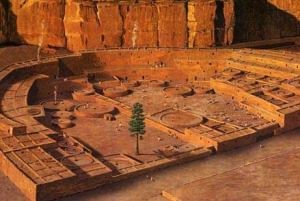
Researchers have found that birth rates and life expectancy in the American Southwest between 900 BC and 1400 AD indicated a period of rapid population growth between about 500 AD and 1100 AD followed by a significant decline after 1300 AD, never again to recover the former growth.
The study, conducted with National Science Foundation funding by anthropology professor Tim Kohler and graduate student Kelsey Reese, both of Washington State University, analyzed data on thousands of human remains found at hundreds of sites across the Four Corners region of the Southwest. The data helped to create a chronology of the region’s “Neolithic Demographic Transition” — a time period when stone tool artifacts signaled the agricultural transition from cutting meat to pounding grain.
“It’s the first step towards all the trappings of civilization that we currently see,” said Kohler.
Maize (corn), the region’s staple crop, was introduced as early as 2000 BC, but productivity was slow to rise until about 400 BC, said Kohler, when the crop is estimated to have provided around 80 percent of the regional population’s calories. A corresponding gradual rise in birth rates ensued until about 500 A.D.
Then, growth rates varied across the region. People in the Sonoran Desert and Tonto Basin, in what is today Arizona, were more culturally advanced, with irrigation, ball courts, and eventually elevated platform mounds and compounds housing elite families. Yet birth rates were higher among people to the north and east, in the San Juan basin and northern San Juan regions of northwest New Mexico and southwest Colorado.
_______________________________________
 Aerial view of Pueblo Bonito in Chaco Canyon, New Mexico. Bob Adams, Wikimedia Commons
Aerial view of Pueblo Bonito in Chaco Canyon, New Mexico. Bob Adams, Wikimedia Commons
_______________________________________
Kohler suggested that the Sonoran and Tonto people might have had difficulty finding new farming opportunities for their posterity, as corn farming required irrigation. Water from canals may have also carried harmful protozoa, bacteria and viruses. But groups to the northeast would have been able to expand maize production into new areas as their populations grew, he said.
Around 900 A.D., populations remained high but birth rates began to fluctuate. The mid-1100s saw one of the largest known droughts in the Southwest, when the region had likely hit its carrying capacity, with continued population growth and limited resources similar to what Thomas Malthus predicted for the industrial world in 1798.
From the mid-1000s to 1280—by which time all the farmers had left—evidence indicates that conflicts raged across the northern Southwest, but birth rates remained high.
“They didn’t slow down—birth rates were expanding right up to the depopulation,” said Kohler. “Why not limit growth? Maybe groups needed to be big to protect their villages and fields.”
“It was a trap,” said Kohler. “A Malthusian trap but also a violence trap.”
The northern Southwest had as many as 40,000 people in the mid-1200s, but within 30 years it was empty. Kohler hypothesizes that the population may have become too large to be sustained as climates deteriorated, and the lower population would not have adequately maintained the social unity needed for defense and new infrastructure.
But whatever the reason, he said, the experience of the ancient Puebloans could suggest that “population growth has its consequences.”
The paper is published in the Proceedings of the National Academy of Sciences as “Long and spatially variable Neolithic Demographic Transition in the North American Southwest,” by Timothy A. Kohler and Kelsey M. Reese.
______________________________________________
Edited and adapted from a Washington State University press release, “WSU Researchers chart an ancient baby boom”.
Cover Photo, Top Left: A digital model of ancient Pueblo Bonito (Chaco Canyon, New Mexico, U.S.) before it was abandoned. Wikimedia Commons
________________________________________________________
Read about the most fascinating discoveries with a premium subscription to Popular Archaeology Magazine. Find out what Popular Archaeology Magazine is all about. AND MORE:
On the go? Purchase the mobile version of the current issue of Popular Archaeology Magazine here for only $2.99.
Popular Archaeology’s annual Discovery Edition eBook is a selection of the best stories published in Popular Archaeology Magazine in past issues, with an emphasis on some of the most significant, groundbreaking, or fascinating discoveries in the fields of archaeology and paleoanthropology and related fields. At least some of the articles have been updated or revised specifically for the Discovery edition. We can confidently say that there is no other single issue of an archaeology-related magazine, paper print or online, that contains as much major feature article content as this one. The latest issue, volume 2, has just been released. Go to the Discovery edition page for more information.






